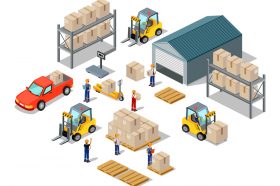Resources - Blog
Can You Start an Amazon Business With No Capital?

Stay on top of the latest e-commerce and marketplace trends.
Joining the Amazon marketplace on the other side of the transaction as a seller and not a customer can be complex, but can also prove to be immensely lucrative if the right preliminary measures and actions are taken and strategies are put into place. It is, in fact, possible to create a successful Amazon online business with little starting capital (approximately $1-2K), but it requires thorough planning, intensive product research, and creativity.
Associated Costs and Fees
How much does it cost to sell on Amazon? When deciding to start an Amazon business, it is important for sellers to consider above and beyond costs that come with getting an, albeit lean, Amazon operation up and running. There are also ongoing fees to take into consideration, such as item storage fees (in Amazon fulfillment centers for FBA and in your own warehouse or third-party logistics provider’s warehouse if FBM or SFP). Below is a list of fees associated with starting and running an Amazon business: 1. The cost of goods per unit, including any taxes and delivery fees. 2. Any company set-up, such as creating a website and logo. If you will be selling private label items, a logo will be required in order to become brand-registered on Amazon. 3. Any packaging costs and design work needed for product labels. 4. The cost of any product photography for your detail pages. Whether you hire a photographer or shoot the items in-house, customers want to see the item from multiple angles, be able to zoom in, and see the item in use or worn depending on what it is. 5. Amazon selling plan costs — Professional vs. Individual. Amazon’s Professional selling plan is available for a monthly subscription fee of $39.99 (40+ items a month). The Individual selling plan is for those who plan to sell fewer than 40 items per month and has no monthly fee associated; individuals instead pay $0.99 per item sold, plus other selling fees which vary by category. 6. Shipping and fulfillment fees. Seller fees vary depending on the fulfillment method chosen, FBA or FBM (which can turn into Seller Fulfilled Prime if a seller qualifies). When sellers use FBM, Amazon shipping rates apply to media products and are based on product category and the shipping service that the buy selects; that fee is then passed onto the seller. For FBA, sellers are charged an order fulfillment fee (which includes order and weight handling fees and pick/pack fees), storage fees, and optional service fees. For both FBM and FBA, sellers need to take shipping supplies (such as boxes and labels) into consideration in their total cost structure. 7. Referral fees. Amazon sellers pay a referral fee on each item sold, ranging anywhere from 8% to 45%. Items in various categories have a per-item minimum referral fee and sellers pay the greater of the referral fee or the per-item minimum referral fee. For all products, Amazon deducts the applicable referral fee percentage calculated on the total sales price, excluding any taxes calculated through Amazon tax calculation services. 8. Refund and closing fees. For each media item that is sold (i.e. books, DVDs, music, and software), Individual and Professional Sellers also pay a variable closing fee. Additionally, if sellers refund a customer for an order that has already been paid for, Amazon will refund the seller the amount of the referral fee the seller paid for the item(s), minus the Refund Administration Fee, which is the lesser of $5 or 20% of the applicable Referral Fee.
How to Cut Costs
When navigating how to start selling on Amazon with limited money, it will be critical to uncover ways new sellers can cut costs. To begin, start out selling and shipping only from within the country of sale to avoid needing to pay any import/export fees or international Value Added tax fees. Once your business has begun to scale, you will be able to consider expanding abroad. Next, start by selling low-risk, non-bulky items. FBA storage and fulfillment fees are based on the size and weight of the items, so starting out with items that are light, easy to ship, and that can have a high markup will help you remain budget-conscious when beginning to sell. Additionally, doing product research in advance of launching your store will help you save money in the long run — finding items with demand but low competition and looking up estimated sales metrics will help support your decision to pursue or skip any given item. Additionally, landing on items that are non-seasonal and therefore are in demand year-round will also be beneficial when first starting out. Items that run out and need to be replenished (i.e. paper for a printer) could also be beneficial as it is bought multiple times a year. Ordering samples of the product once you have pinpointed potential suppliers and their minimum order quantities is also recommended so that you can look at, touch/feel, and inspect the item how a customer would receive it.
Becoming Profitable
Once your Amazon listings go live and sales gradually begin to roll in, the task transitions to maintaining optimized product pages and customer satisfaction and establishing credibility. The sellers with four- and five-star product reviews and positive seller feedback are the ones who are going to experience an increase in sales volumes, as many customers will only make purchases on products with positive reviews. Additionally, Amazon seller software is available to help sellers navigate a variety of aspects of their business: precise stock and inventory management, strategic repricing, competitor analysis, advertising, returns management, and more. For increased product discoverability, advertising through Headline Search Ads and Sponsored Products Ads will significantly aid to boost product rank and conversion. In order to maximize your profits once you have established a presence on the marketplace, you can gradually expand your product line and work to take advantage of seasonal trends and/or the high-volume Q4 holiday season.
Learn what Feedvisor can do for your business.
When you partner with Feedvisor, you automatically receive access to our true, AI-driven technology and hands-on team of e-commerce experts. Contact one of our team members today to learn more about our end-to-end solution for brands and large sellers on Amazon, Walmart, and e-marketplaces.



